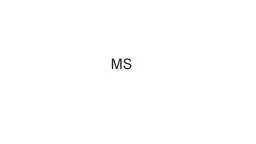

JeanMartin Charcot lectured on the features of MS and gave it a name la sclérose en plaques The word sclerosis comes from the Greek word skleros meaning hard plaques ID: 931719
Download Presentation The PPT/PDF document "MS Since the late 1300s, individuals wit..." is the property of its rightful owner. Permission is granted to download and print the materials on this web site for personal, non-commercial use only, and to display it on your personal computer provided you do not modify the materials and that you retain all copyright notices contained in the materials. By downloading content from our website, you accept the terms of this agreement.
Slide1
MS
Slide2Since the late 1300s, individuals with a progressive illness suggestive of MS have been observed. It wasn’t until 1868 that the famous neurologist,
Jean-Martin Charcot, lectured on the features of MS and gave it a name 'la sclérose en plaques‘. The word sclerosis comes from the Greek word "skleros," meaning hard = "plaques"
A glimpse Into History
Slide3What is multiple sclerosis?
Multiple sclerosis (MS) is a chronic disease characterized by inflammation and demyelination of the central nervous system (CNS) associated with variable degrees of axonal and neuronal damage.
It usually presents with recurrent, subacute, focal neurologic symptoms and signs that improve (at least to some extent) over several weeks or months. The disease may initially present with (less often) or evolve into (more common) a relentless progressive decline of neurologic functioning, commonly affecting locomotion, bladder function, and cognition.
Slide4MS phases
High Risk
RR
PP
Slide5Pathogenesis
B/T lymphocytes
Meningeal lymphoid follicle like aggregate
Axonal injury
Demyelinated plaques
MS
T and B lymphocyte–mediated disease, affect both grey and white matter
Autoreactive lymphocytes that gain access to the CNS start a pathogenic cascade that culminates in demyelination,
neuroaxonal
degeneration, synaptic loss, dying-back
oligodendrogliopathy
, and, eventually, tissue loss and astrogliosis.Demyelinated plaques : pathologic markers of MS , loss of oligodendrocytes, loss of myelin sheaths, and astrocytic scars.Axonal injury is present, even from the earliest stages of MS, contributes disability.
Meningeal lymphoid follicle–like aggregates : ongoing sequestered intrathecal inflammation might be a factor contributing to progression.
Slide6Schumacher Criteria
McDonald Criteria
2010
Revised McDonald
Criteria
2017
Diagnostic Criteria
Slide7Schumacher
Criteria
The identification of a syndrome “typical” of MS-related demyelination
Objective evidence of central nervous system (CNS) involvement
Demonstration of dissemination in space
Demonstration of dissemination in time
“No better explanation” other than MS
Slide8The identification of a syndrome “typical” of MS-related demyelination
Transverse myelitis
Cerebellar syndromes
Brainstem syndromes Optic neuritis
Slide9Objective evidence of central nervous system (CNS) involvement
ClinicalRadiographic
Para-clinical
Slide10Dissemination
in SpaceFulfillment of dissemination in space requires detection of lesions in more than one distinct anatomic location within the CNS (periventricular, cortical or juxtacortical, infratentorial brain regions and the spinal cord)
Slide11Dissemination
in TimeFulfillment of dissemination in time requires confirmation of new CNS lesions over time.
Slide12“No Better Explanation”: the Differential Diagnosis of Relapsing-Remitting Multiple Sclerosis
As no single biomarker for MS exists, each revision of MS diagnostic criteria has also specified that there must be a determination of “no better explanation for the clinical presentation under consideration.The authors of the 2017 McDonald criteria also recommend application with caution in diverse populations (nonwhite) and patients younger than 11ys or older than 50ys , in whom the 2017 McDonald criteria have not been evaluated.
Slide13Better Explanation for Typical Syndromes
Clinical, laboratory, or radiographic findings atypical for MS and suggestive of an alternative diagnosis that may offer a better explanation than MS for the clinical presentation.NMO/neurosarcoidosis more commen in non-white than MS.Longitudinally extensive transverse myelitis may suggest NMOSD, neurosarcoidosis
, anti-MOG–associated myelitis, systemic rheumatologic disease, or a paraneoplastic disorderSevere or bilateral optic neuritis may suggest NMOSD
Slide14Transverse myelitis associated with prodromal symptoms or MRI T2 signal abnormality confined to spinal cord gray matter may suggest anti-MOG–associated myelitis
Multiple cranial nerve involvement might suggest neurosarcoidosis.Transverse myelitis or optic neuritis accompanied by high CSF pleocytosis should also prompt investigation into infectious or inflammatory disorders other than MSSystemic symptoms such as joint pain, skin changes, and weight loss might suggest either rheumatologic or paraneoplastic disease
Slide15Expanding the Differential Diagnosis and Red Flags to
Noninflammatory DisordersLets play a game
Slide16Avoid Misdiagnosis
Don’t count cortical/subcortical lesions , >3mm , >6mm.CSF oligoclonal band –ve < repeat later.On atypical presentation, dig deeper , investigate more. Juxatcotrical/periventricular lesions should abut the cortex/ventricles.Age 11-50 , white.Callosospetal lesion favor MS.
Always re-evaluate preexisting MS diagnosis.16
Slide17McDonald Criteria
Slide18Radiological cases
https://radiopaedia.org/cases/optic-neuritis-multiple-sclerosis?lang=ushttps://radiopaedia.org/cases/multiple-sclerosis-teaching?lang=ushttps://radiopaedia.org/cases/neuromyelitis-optica-4?lang=us
https://radiopaedia.org/cases/multiple-sclerosis-42?lang=gbhttps://radiopaedia.org/cases/tumefactive-multiple-sclerosis-1?lang=gb
Slide19PPMS
Slide20Slide21Slide22Thank You!